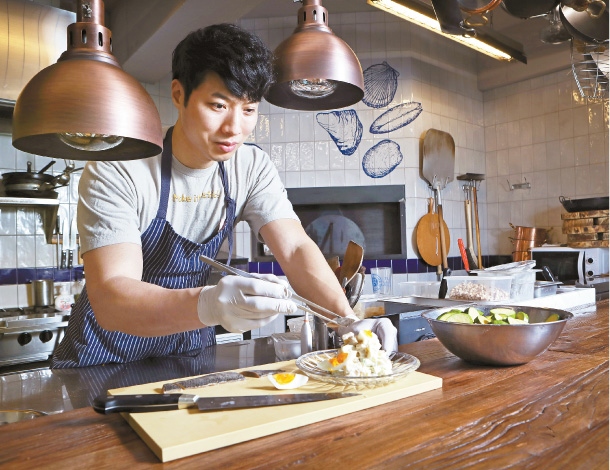Adding a rustic touch to Western dishes : Lee Kyung-ho uses Korean ingredients to appeal to many diners
Published: 16 Apr. 2020, 21:00

Chef Lee Kyung-ho of Sigolo in southern Seoul’s Gangnam District makes a potato salad, a signature dish at the restaurant. [PARK SANG-MOON]
What he wanted to do was very clear: make a restaurant that’s comfortable enough for a customer to visit often. That idea appealed to many diners who wouldn’t normally go to a fine dining restaurant every day.
His food is meant to be shared. The portions are bigger than dishes served at other restaurants serving a la carte dishes nearby, and he even does a family-style Mexican platter on the weekend to attract large groups looking for a party-style meal. The pizzas he serves are big enough to share, and the clams on top come fresh from a tank inside the restaurant.
“I want my restaurant to be a place where people want to bring their parents or young children for a family gathering, or their coworkers for a team dinner,” said Lee.

At Sigolo, ingredients commonly found in Korean cooking are used to make Western-style dishes. [PARK SANG-MOON]
While some Western dishes are made to target the tastes of youngsters, he tried to include as much Korean character into his dishes that he could. His beef tartar comes with diced-up octopus, inspired by the combination of the two widely served in Korean restaurants that serve yukhoe, or raw meat. He also adds galchi, also known as beltfish, to the restaurant’s pasta, a common ingredient on Korean tabletops.
He calls the dishes that he makes rustic cuisine. The dishes are fresh as if all the ingredients are sourced right from the countryside and comfortable to eat. Who says that grandpas always want to eat classic Korean dishes every day, the chef wondered. He wanted to offer a chance for even the generations unfamiliar with Western foods to try something new at Sigolo with their grandchildren.
“Korean people find it comfortable and foreigners find it entertaining,” said the chef, adding that something so simple for Koreans can be international, and that is what he wants to do.
“I like to twist something classic to fit it to my style because creating something completely new is so difficult and maybe impossible, as nothing really is new.”
Lee has been making these kinds of dishes since his time working at a restaurant in Yeonnam-dong, western Seoul. He spent about three years working on his take on rustic cuisine, in a way to differentiate what he does from other chefs in Korea or even in the world.
The idea of making rustic cuisine was shaped from his travels to New York whenever he could over the past decade. A mentor of his used to work in New York and told him about the diverse dining scene in the city, so he tried out as much as he could, ranging from fine dining to street vendors to get more inspiration and study flavors that could work not only for the tastes of Koreans but also for diners traveling to Korea. He found that there were no set boundaries from one cuisine to another at restaurants in New York as chefs there actively pursue their own style.
Lee also has plans to bring his rustic cuisine to the real countryside. He dreams of opening a restaurant outside of Seoul in the future, where he can have a farm in the back and families can stop by on their way out to a picnic or on their way back home.
The practice of rustic cuisine can shine more in a place that is actually rustic, he says. He believes that the core of the rustic cuisine comes from using ingredients that are seasonal, so everyone can feel the changes of the season on the plate. To make that dream come true, he has been spending time cultivating his own farm in a very small lot over the past few years.
“I want people to get together, talk loudly and laugh out loud, so that they are happy as they eat and build up memories together,” said Lee.
“Many young kids who were raised in the city probably won’t know sigol as we know it, and I want them to have a place where they can eat and play by fields filled with rice and a farm filled with cows mooing.”
Sigolo
Executive chef
Lee Kyung-ho
Cuisine
Rustic
Address
27-3 Seolleung-ro 146-gil, Gangnam District
Phone number
(02) 6489-3338
Hours of operation
Wednesday to Saturday: 5:30 p.m. to 12 a.m.
Sunday: 12 p.m. to 10 p.m.
(Break time: 3 p.m. to 5:30 p.m.)
Price range
Small bites start from around 9,000 won.
@sigolo.seoul
BY LEE SUN-MIN [summerlee@joongang.co.kr]










with the Korea JoongAng Daily
To write comments, please log in to one of the accounts.
Standards Board Policy (0/250자)